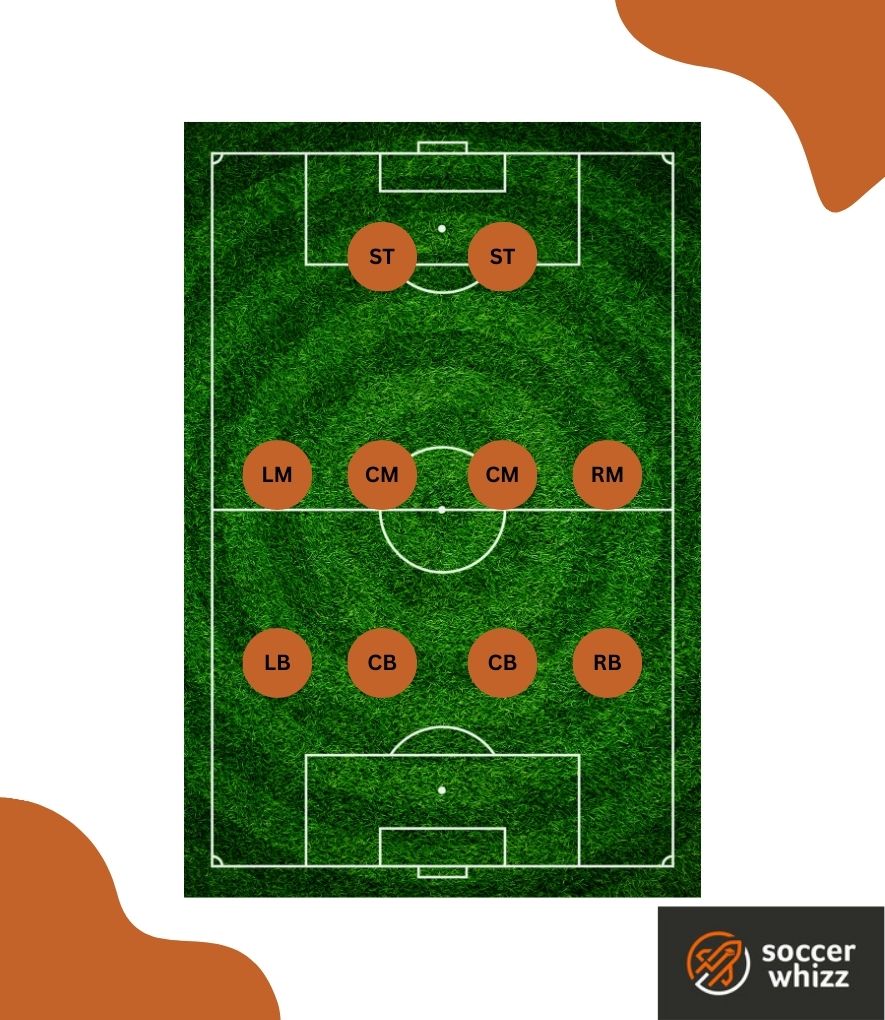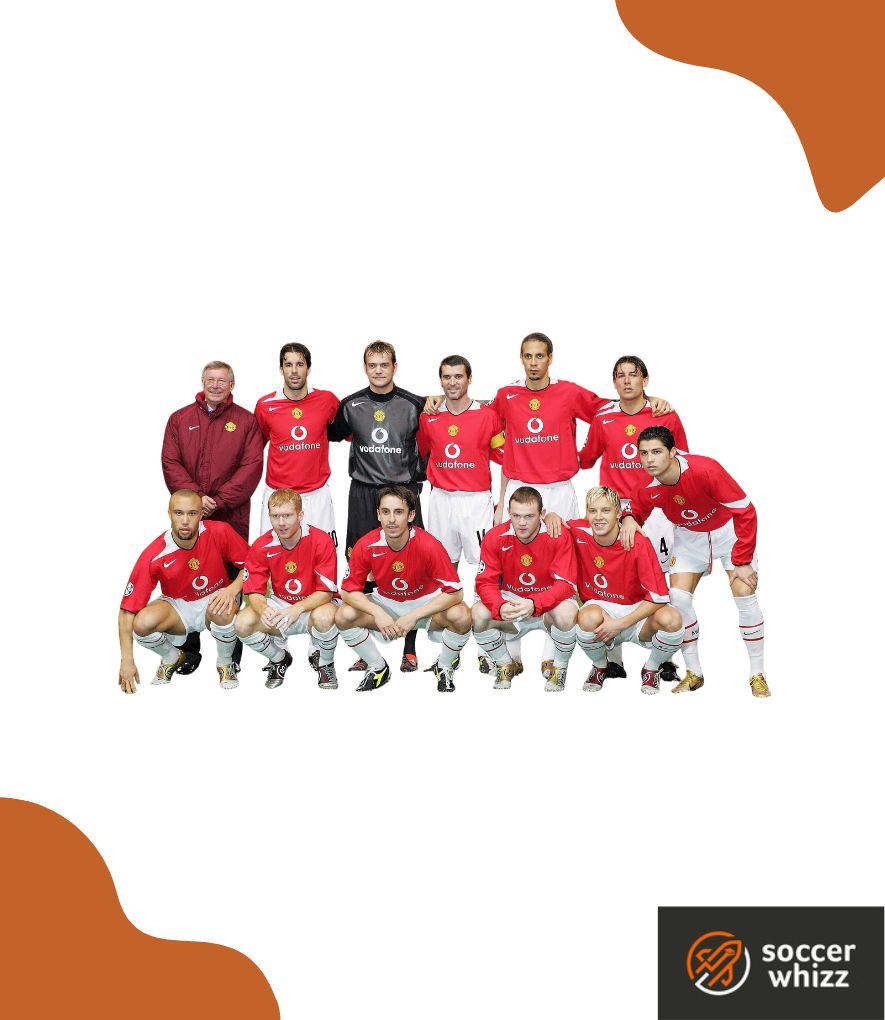In the ever-evolving world of soccer, where tactical innovations constantly emerge, one formation has managed to withstand the test of time as a timeless classic – the 4-4-2.
With a history dating back to the early days of the beautiful game, this formation has been a cornerstone of numerous successful teams across various eras.
Despite the proliferation of modern systems, the 4-4-2 remains a steadfast choice for coaches seeking a balanced, adaptable, and effective approach to the sport.
In this article, we delve into the intricacies of the 4-4-2 soccer formation, exploring its origins, key principles, tactical nuances, and the reasons behind its enduring popularity.
- How does the 4-4-2 formation work?
- What are the strengths of a 4-4-2 formation?
- What are the weaknesses of a 4-4-2 shape?
- Which soccer teams have thrived with the 4-4-2 as their primary playing shape?
- What approach can you use to counter a 4-4-2 tactic?
- Is the 4-4-2 formation likely to rise back to prominence in the future?
- Closing thoughts
How does the 4-4-2 formation work?
The fundamental principles of a 4-4-2 soccer formation are straightforward.
This tactical setup features four defenders at the back, comprising two center-backs, a right-back, and a left-back.

The primary defensive responsibilities lie with the right-back and left-back, commonly known as full-backs, as they offer width on the offensive side through two wide midfielders positioned ahead of them.
Nestled between these winger positions is a central midfield duo, forming the core of the midfield quartet.
Among the central midfielders, one typically assumes a deeper role, prioritizing defensive cover, while the other takes on a more dynamic role, advancing forward to create attacking chances.
Lastly, the 4-4-2 formation employs a strike partnership, with these two forwards actively pressuring the opposing defenders and consistently providing an outlet for the midfielders and defensive line.
What are the strengths of a 4-4-2 formation?
Tailored for counter-attacking football, the 4-4-2 formation presents both challenges and immense effectiveness when executed correctly.
With its strong defensive line, wide attacking presence, and swift transition into forward areas, the 4-4-2 system proves to be a formidable choice for teams seeking to capitalize on counter-attacks (we’ll delve into examples of teams that have thrived with this setup).
For coaches prioritizing a defensive approach, inviting pressure while allowing opponents possession, this formation offers an ideal setup.
The four defenders and four midfielders can form a compact “two banks of four” in front of the 18-yard line, while the two forwards remain poised high up the pitch, ready to exploit any counter-attacking opportunities.
The presence of two strikers in this formation deserves special attention, as it’s a rarity in modern football.
Defending against a strike partnership can prove immensely challenging, as defenders are deprived of the luxury of time and space they would have against a lone central striker.
The constant threat of being drawn into one-on-one situations favors the attackers, putting immense pressure on opposition central defenders.
Additionally, playing out from the back becomes significantly tougher with two attackers consistently applying pressure, leaving little room for error.
What are the weaknesses of a 4-4-2 shape?
The 4-4-2 formation places high demands on teams, necessitating discipline and hard work throughout the pitch.
Firstly, the wide midfielders must excel in both initiating swift counter-attacks and carrying the ball forward with pace, while simultaneously being diligent in tracking back to provide cover for their full-backs.
The defensive central midfielder faces a challenging role, often finding themselves outnumbered in crucial central areas.
Their box-to-box midfield partner requires immense energy and stamina, while the forwards must demonstrate intense pressing, proficient ball retention, and the ability to involve midfielders effectively.
Essentially, the 4-4-2 system allows no room for passengers; each player must contribute actively.
While the 4-4-2’s strengths lie in its defensive solidity and effective counter-attacking, it can hinder a team’s ability to control and dominate possession.
Teams employing this formation may willingly cede possession to the opposition for extended periods, displaying disciplined patience and waiting for opportune moments to strike.
However, this defensive-mindedness can sometimes stifle the creativity of more attack-minded midfielders who prefer to assert dominance higher up the field.
Arguably, the formation’s primary weakness lies in its vulnerability to being overrun in midfield.
When facing a 3-man midfield, the 2 central midfielders may struggle to win the central battle, allowing the opposition to exploit spaces and pass through their ranks easily.
For coaches seeking to dominate possession in midfield, the 4-4-2 system may not be the most suitable choice.
Which soccer teams have thrived with the 4-4-2 as their primary playing shape?
1. Atletico Madrid
Atletico Madrid under the guidance of Diego Simeone stands as the epitome of success when it comes to deploying the 4-4-2 formation.

Renowned for their disciplined and compact 4-4-2 shape, they excel in absorbing pressure, controlling the pace of games, and unleashing devastating counter-attacks on their opponents.
This well-crafted strategy has proven highly effective, culminating in an impressive array of honors, including:
- two La Liga titles;
- two Europa League trophies;
- two Super Cups; and
- two UEFA Champions League finals appearances.
2. Manchester United
Over the course of his remarkable 27-year tenure at Manchester United, Sir Alex Ferguson cemented his legacy as arguably the greatest British manager ever, honing the 4-4-2 formation to a level of perfection.

With a roster boasting solid and dependable defenders such as Jaap Stam, Gary Neville, Rio Ferdinand, and Nemanja Vidic, alongside hard-working and talented wide players like Ryan Giggs, David Beckham, and Cristiano Ronaldo, Sir Alex Ferguson’s teams achieved an ideal equilibrium between defensive solidity and attacking prowess.
3. Leicester City
A shining illustration of the 4-4-2’s effectiveness emerged during Leicester City’s remarkable title-winning campaign in the 2015-16 season.

Despite facing formidable odds and operating with limited financial resources as a recently-promoted team, they astounded football fans by decimating opponents through the sheer brilliance of their counter-attacking style.
Key to their success was a combination of impeccable organization and the star quality of standout players like N’golo Kante, Riyad Mahrez, and Jamie Vardy.
What approach can you use to counter a 4-4-2 tactic?
One effective method to counter the 4-4-2 formation is by adopting a 4-5-1 shape.
This tactical approach empowers teams to overwhelm the opposition’s midfield while maintaining ample width for both attacking purposes and thwarting potential counter-attacks from the wide midfielders.
By embracing the 4-5-1 system (explore further in our comprehensive guide to the 9 best soccer formations), teams can also unleash a front 3 in the attack, making incisive runs beyond the opposition’s full-backs and creating favorable 1v1 situations in dangerous areas.
Alternatively, a more direct approach can prove fruitful in dismantling the 4-4-2 structure.
Once again, aligning in a 4-5-1 shape, the focus shifts from possession dominance to swiftly playing the ball forward to the central striker and supporting wingers.
The midfield trio becomes instrumental in securing loose balls after the initial aerial battles.
Utilizing quick forward passes into the wide channels provides an opportunity for the wingers to exploit the gaps that a narrower and more rigid 4-4-2 formation might leave open.
This method capitalizes on speed and precision to break down the opposition’s defensive setup effectively.
Is the 4-4-2 formation likely to rise back to prominence in the future?
Modern football has seen a shift towards more fluid formations, such as variations of the 4-3-3, 4-2-3-1, and 3-4-3, which emphasize positional flexibility and dynamic movement.
Coaches often tailor their formations to suit the strengths of their players and the tactical demands of the game.
That being said, soccer is a sport of constant evolution, and there is always the possibility of tactical trends circling back to older formations.
Adaptations or modifications of the 4-4-2 might resurface as coaches seek to capitalize on its defensive solidity and counter-attacking potential.
Additionally, some teams might experiment with hybrid formations that incorporate elements of the classic 4-4-2.
Closing thoughts
In conclusion, the 4-4-2 formation stands as an enduring testament to the timeless principles of balance, teamwork, and adaptability in the beautiful game of soccer.
From its humble beginnings to its storied history, this classic tactical setup has left an indelible mark on the sport, shaping the fortunes of legendary teams and managers alike.
While modern football has witnessed a shift towards more fluid and dynamic formations, the 4-4-2 remains a tactical gem cherished by those who value defensive solidity, efficient counter-attacks, and positional discipline.
Its ability to strike a harmonious equilibrium between defensive stability and attacking potency has led to numerous successful campaigns for both historical powerhouses and underdog teams.
For more reading on similar formations, you can have a read of our separate article on the 4-5-1 formation.
If you enjoy the content that I create and would like to buy me a coffee, then I’d really appreciate it!
Any money that I earn through this donation will be re-invested into more content for this website.
Additionally, by sending in a donation you’ll also receive a copy of my recently released 190+ page eBook on Soccer Ball Care, as well as be subscribed to our mailing list where you’ll be regularly informed on the latest developments concerning the Soccer Whizz blog.
- Future Icons: Europe’s Emerging Midfield Maestros Set for Glory - December 4, 2023
- Kickstarting a Revolution: How Soccer Transformed the United States Over the Last Four Years - October 7, 2023
- 4-1-4-1 Soccer Formation [Analysis] - September 23, 2023

